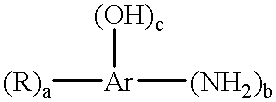Two-stroke cycle lubricant and method of using same
a technology of two-stroke cycle lubricant and method, which is applied in the direction of fuels, machines/engines, mechanical equipment, etc., can solve the problems of piston lubricity, scuffing or scoring, and spark plug fouling,
- Summary
- Abstract
- Description
- Claims
- Application Information
AI Technical Summary
Problems solved by technology
Method used
Image
Examples
example a-2
To a mixture of 361.2 parts of a deca(propylene)-substituted phenol and 270.9 parts of glacial acetic acid, at 7.degree.-17.degree., is added a mixture of 90.3 parts of nitric acid (70-71% HNO.sub.3) and 90.3 parts of glacial acetic acid. The addition is carried out over 1.5 hours while the reaction mixture is cooled externally to keep it at 7.degree.-17.degree.. The cooling bath is removed and the reaction stirred for two hours at room temperature. The reaction is then stripped at 134.degree. / 35 torr and filtered to provide the desired nitrated intermediate as a filtrate having a nitrogen content of 4.65%.
A mixture of 150 parts of the above intermediate and 50 parts of ethanol is added to an autoclave. This mixture is degassed by purging with nitrogen and 0.75 part of palladium on charcoal catalyst is added. The autoclave is evacuated and pressured with nitrogen several times and then put under a hydrogen pressure of 100 psig. The reaction mixture is kept at 95 to 100.degree. for 2...
example a-3
To a mixture of 3685 parts of a polybutene- substituted phenol (wherein the polybutene substituent contains 40 to 45 carbon atoms) and 1400 parts of textile spirits is added 790 parts of nitric acid (70%). The reaction temperature is kept below 50.degree.. After being stirred for about 0.7 hour, the reaction mixture is poured into 5000 parts of ice and stored for 16 hours. The organic layer which separates is washed twice with water and then combined with 1000 parts of benzene. This solution is stripped to 170.degree. and the residue filtered to provide the desired intermediate as a filtrate.
A mixture of 130 parts of the above intermediate, 130 parts of ethanol, and 0.2 part of platinum oxide (86.4% PtO.sub.2) is charged to a hydrogenation bomb. The bomb is purged several times with hydrogen and then charged to 54 psig. with hydrogen. The bomb is rocked for 24 hours and again charged to 70 psig. with hydrogen. Rocking is continued for an additional 98 hours. Stripping of the resulti...
example a-4
A mixture of 105 parts of the intermediate of Example A-3, 303 parts cyclohexane and 4 parts commercial Raney nickel catalyst is charged to an appropriately sized hydrogenation bomb. The bomb is pressured to 1000 psig. with hydrogen and agitated at about 50.degree. for 16 hours. The bomb is again pressured to 1100 psig. and agitated for another 24 hours. The bomb is then opened and the reaction mixture filtered and recharged to the bomb with a fresh portion of 4 parts of Raney nickel catalyst. The bomb is pressured to 1100 psig. and agitated for 24 hours. The resultant reaction mixture is stripped to 95.degree. / 28 torr to provide the aminophenol product as a semi-solid residue.
PUM
| Property | Measurement | Unit |
|---|---|---|
| temperatures | aaaaa | aaaaa |
| temperatures | aaaaa | aaaaa |
| time | aaaaa | aaaaa |
Abstract
Description
Claims
Application Information
 Login to View More
Login to View More - R&D
- Intellectual Property
- Life Sciences
- Materials
- Tech Scout
- Unparalleled Data Quality
- Higher Quality Content
- 60% Fewer Hallucinations
Browse by: Latest US Patents, China's latest patents, Technical Efficacy Thesaurus, Application Domain, Technology Topic, Popular Technical Reports.
© 2025 PatSnap. All rights reserved.Legal|Privacy policy|Modern Slavery Act Transparency Statement|Sitemap|About US| Contact US: help@patsnap.com



